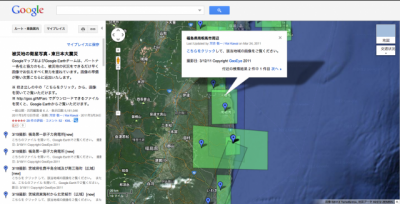Lessons from 3.11 #02: Google maps+satellite/aerial photos+car probe=very useful!
When 3.11 (i.e. Great East Japan Earthquake) took place three years ago, Google was very quick to respond.
A few Googlers started working on localization of Google Person Finder; it was up and running within 106 minutes after the earthquake. That was when Google has opened and announced first version of Google Crisis Response page in Japanese.
Six hours after that, the team found out, most people were still using feature phone (back in 2011) and couldn't access the web page, so they have modified Person Finder and made it accessible via Japanese feature phones.
(FYI. after Typhoon Yolanda hit Philippines in 2013, Person Finder also became accessible through SMS).
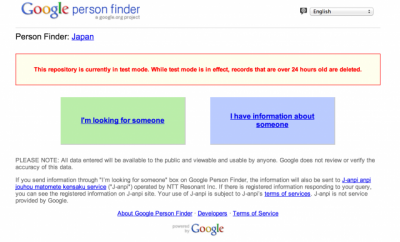
Google Person Finder will let you search (or report), if your friends/family are ok after a disaster. Click the image above to try it out in test mode.
Another group lead by Kei Kawai started to prepare satellite photos and aerial photos of the area of damage; Kei did so after the advice of Kevin Reece, who had experience in responding to a big natural disaster and who knew aerial photos will be very important.
Before I explain further, perhaps, I need to clarify the difference between Satellite photos and aerial photos. As the name implies Satellite photos are took in space (by the Satellite) while aerial photos are taken from the sky by airplanes. Because the distance between the ground is greater, satellite photos are good enough to recognize landscape and bigger architectures, but it is not as clear in detail as aerial photos.
The Google team asked Japanese government for permission but they was not as cooperative as Google expected, so it took a while until Google was able to provide the first aerial photos.
In order to prevent this kind of mishaps, I will explain why you would need it.
The aerial photos are, of course, very useful for the victims and those worried to recognize how severe the damage was.
But it is not just that.
It will be used among the rescue team to recognize how they can approach the area of severe damage (e.g. which shore, which road, which landing points, etc.).
It will also be used among those rescue team to mark which areas are searched, etc.
Aerial photos can also be used by those people who are planning to build shelters.
Satellite photos may also help. But it is best, if you have clearer aerial photos.
After the earthquake in 2011, Kei Kawai in Mountain View was perhaps, one of the first Japanese to receive GeoEye's satellite images of Tohoku after earthquake.
By then, Google was receiving request from Japanese media for satellite images of Fukushima, but he couldn't help himself from checking the image of coastal town in Minami Soma; his wife was from there. He was so surprise to see the coastline have shifted so much but was able to recognize her wife's house was still there after the tsunami.
These images were later used used on Google Earth but Google Earth is a gigantic complex system, and it will take time to update image, and it will take further time until everyone will be able to see the image.
But Kawai, knew some people want to use the images as soon as possible. So he picked some of the best satellite images, uploaded them to his Picasa image sharing service, then created a link on his Google MyMap.
This approach was invented by some Googlers in the UK, but Kawai took over their effort.
If someone click an area on that MyMap, the web browser would display the picture shared via Picasa.
Uploading the image to Picasa had a nice side effect. People concertned about particular area was able to form community through the comment area of Picasa exchanging information or even leaving a 'thank you' note to Google.
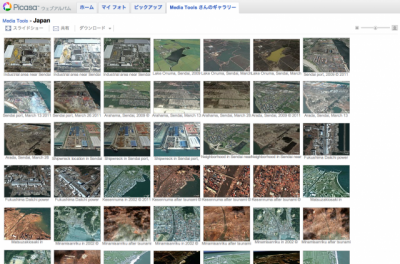
Because it would take time to update Google Earth and Google Maps, Kawai has uploaded Satellite photos on Picasa
Although Google wanted to take aerial photos immediately after the earthquake, because the Japanese government was not as cooperative, they had to wait for two weeks until they finally were able to start taking aerial photos; those photos were shared through Google Earth and Google Maps on March 31st, and the world saw how big the damage was.
While Kei Kawai and other Googlers were working hard to get clear photos of the damaged area in Tohoku, a Japanese car manufacturer, Honda was trying to spread an important information.
Honda has an advanced telematics services for their cars called Internavi since 1998.
One of the interesting feature of Internavi is that it can share the probe information with other Internavi users; i.e. you can share information about where your car is and how fast it is moving. With this information, driver of cars equipped with Internavi will know the average speed of cars on each streets across Japan.
Back in 2004, there was a big earthquake near Niigata Prefecture (Niigata Prefecture Chuetsu Earthquake ) and Honda's Internavi team found another interesting use of car probe information; it will visualize which roads are not working.
If you have a big disaster, roads will be closed for landslides, for fallen trees, for tsunami, etc.
And those car heading to rescue the victims will waste great deal of time figuring out how they can approach the damaged area.
But Internavi team knew which roads are dead and which roads are alive because if a road is closed there will be no records of car probe on that road.
So in 2011, Internavi team of Honda has compiled a car probe data gathered from Internavi, compiled it as a KML file (a geographical data that can be overlayed on Google Earth) and shared it via Twitter.
Many people tried to connect the guy from Honda to people at Google (I was among the many who tried it). Later, they found each other and started a joint effort and ultimately, it has become part of the many Google Crisis Response service unique to Japan.
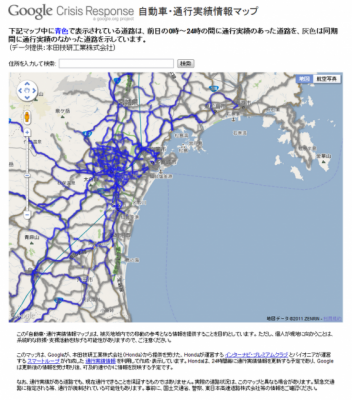
Honda Internavi car probe data mapped over Google Map (and offered as part of Google Crisis Response)
This information was so useful. One of my photographer friend check this info on his iPhone and drove all the way to Tohoku.
Kazuma Watanabe is a head of an NPO who helped so many after the earthquake; Kazuma arranged a few cars full of goods heading toward coastal area where Tsunami hit. In the mean time, he stayed in Sendai and was checking the probe information and directed which road his staffs should take through phone calls.
Let me walk through how these information can be useful in action.
Let's say, you are heading to Shiogama city through a coastal highway and check Google x Honda probe information. And then, you find people are avoiding the area around Sendai Airport and Natori river.
So I would open Google maps or Google Earth and check what's over there.
And you find the bridge over Natori river were taken down by the Tsunami and gone.
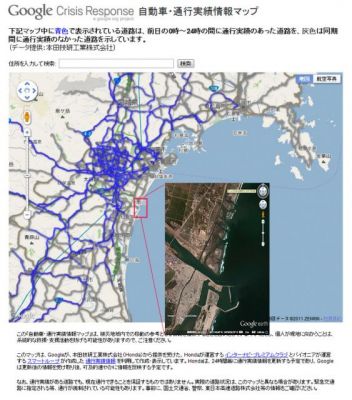
You found via probe information people are avoiding Natori River; you check the area with satellite image to find the bridge is gone
In the auto industry, 'telematics' has been a big area of innovation.
Those people working on telematics should take what Honda Internavi and Google did here in Japan into account; it can be very important worldwide.
Lastly, I want to share a very interesting feature of Google Earth.
Google has actually put a 'time machine' in there.
Launch the Google Earth application and display any coastal area in Tohoku.
In this case, I would like to use Sendai airport as an example.
So launch Google Earth and search for Sendai Airport.
Then, go to the toolbar and click on the time machine icon.
Browsing through the time, you may be surprise how quickly the airport has been restored.
If you want to see the image of Tohoku before and after the earthquake/tsunami, 'Memories for the Future' http://www.miraikioku.com/en/ by Google is another interesting Web Site to visit.

